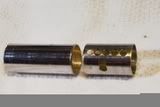The SLEEVE
This is an idea that may be beyond the technical ability of many locksmiths or pickers as it requires some machine work. It creates a cylinder that deceptively appears 99% normal but has much increased pick resistance. I used a take out Kwikset knob cylinder as my prototype. Most locksmiths I challenge will be suspicious at the suggestion that they cannot pick a simple Kwikset even when I show them the key cuts. For the purposes of my test or bar bet I promised that I would use no spool pins.
Remove the cap, plug retainer, and all pins. In other words, strip it down.
I measured the plug diameter and found it to be .5" (1/2 inch). I took a piece of brass plumbing pipe and drilled a hole in one end the same size and the length of the plug. It was a little tight and I used sanding cloth on a split dowel to polish the inside until the plug would fit smoothly.
I then drilled out the cylinder housing to the same size as the outside of the brass pipe (about 9/16"). The thickness of the new brass pipe sleeve is now .030" (thirty thousandths of an inch). I cut the sleeve off and carefully smoothed the ends. The length is exactly the length of the plug to the inside of the spring retainer clip. The sleeve must be free to spin and the retainer must put no resistance on the sleeve.
I slipped the sleeve onto the plug and locked it in place with the retainer. I then drilled through the sleeve at the location of the original five pin holes using a #32 (.116) drill. After drilling the first hole I inserted a long pin to help freeze the sleeve location in respect to the other four holes. I drilled through the sleeve and into the existing pin holes without doing any damage to the original holes.
I left this drill in the hole to lock the plug and sleeve together and in line with the pin holes and rotated the plug and sleeve in the vise by about 30 degrees. I then drilled one hole (.110), located between two pins and not in line with either. This hole only needs to be deep enough to hold a Best pin in place with exactly .030 sticking out. (This is the exact thickness of the sleeve.) I removed the drill bit, plug retainer and plug.
I then removed the sleeve and re-drilled the pin holes to #30 (.128). I also re-drilled the .110 hole in the sleeve. (Leave the plug hole at .110"). I then carefully filed the offset hole about .020 (twenty thousandths) in both directions. I then cleaned the burrs from the inside of the sleeve with a 45 cal. gun cleaning brush, again making certain that the sleeve would rotate smoothly around the plug.
Assemble the sleeve on the plug. Insert a Best pin in the offset hole and verify that the sleeve will rotate .020 in both directions. Also verify that the plug and sleeve will rotate freely inside the cylinder housing. Insert a precut key and load bottom pins to the outer shear line of the sleeve. Caution: Make sure not to use a key cut so deeply that its bottom pin rests above the shear line between the plug and the sleeve when the key is out and the pin is at rest at the bottom of the plug. (A Kwikset #6 cut depth on the key requires too long of a bottom pin). Balance the top pin lengths to prevent crushing a spring. Remember that the spring chamber is now .030" shorter. In any other cylinder I would use slightly stronger springs. But that would not work with the snap on spring cap of the Kwikset. Lube with dry graphite or Teflon.
Bumping? I sincerely doubt that bumping or use of a pick gun can create the .030" plus gap required to open this lock.
The pick resistance of this modified cylinder comes from the idea that when the picker applies turning pressure, the plug will rotate in the sleeve before the sleeve rotates. The top pins down in the plug will have turning shear pressure on them. As a bottom pin is lifted, the pressure will be relieved at the first shear line between the plug and the sleeve. Once all bottom pins are set and the plug has been picked in the sleeve none of the pins can be moved again even though all bottom pins are completely free. All top pins are now locking the sleeve in place and the small pin in the slot prevents the plug from turning further. The plug must be returned a few degrees in the opposite direction to center the sleeve and to allow the top pins to spring downward again.
Use standard top pins while testing and having fun and move on to a couple of spools later. The spools or reverse spools with a step are guaranteed to catch on the sleeve and really mess with the picker's mind.






